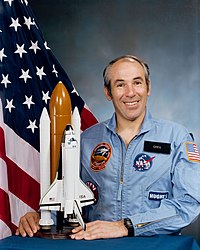Gregory Bruce Jarvis
| Gregory Jarvis | |
|---|---|

|
|
| Country: | United States |
| Organization: | Hughes |
| selected on | 5th July 1984 |
| Calls: | 0, plus STS-51-L |
| Start of the first space flight: |
January 28, 1986 |
| Landing of the last space flight: |
(killed at start) |
| retired on | January 1986 (accident) |
| Space flights | |
|
|
Gregory Bruce "Greg" Jarvis (born August 24, 1944 in Detroit , Michigan USA ; † January 28, 1986 near Cape Canaveral , Florida ) was an American technician who worked as a payload specialist on the space shuttle flight STS-51-L (Space shuttle Challenger) took part and was killed.
Life
After high school, Jarvis attended the State University of New York at Buffalo and received his bachelor's degree in electrical engineering in 1967 . He continued his studies at Northeastern University in Boston , Massachusetts and passed his master's examination in 1969 . During this time he also worked for the US defense and electronics company Raytheon , where he was involved in the development of the SAM-D surface-to-air missile.
Jarvis joined the US Air Force (USAF) in the summer of 1969 . He was sent to California to work in the satellite communications program office of the USAF space division. There he worked as an electronics expert on the development of military communications satellites until he left the Air Force. In Los Angeles , he attended West Coast University and studied scientific management. He attended all the necessary courses for a master’s degree , but did not take the exam.
Career
After his honorable departure from the USAF, Jarvis found a job with Hughes Aircraft in 1973 . He was a technician in the space department and worked on the MARISAT program (MARItime SATellite). Two years later he was promoted to integration manager for the third member of this satellite series, which was launched in October 1976. In 1978 he was transferred to the Advanced Program Laboratory , where he developed the Syncom IV (LEASAT) military satellite , which was designed for launch with the space shuttle . Later he was development engineer for the satellite structure and finally head of the integration department for the first LEASAT satellites.
Jarvis was selected from 600 company-owned applicants for a flight on the US space shuttle. It was originally scheduled to launch on STS-51-D in the spring of 1985, when a LEASAT satellite was deployed. Due to changes in the shuttle flight planning, Jarvis' deployment slipped first to 51-I , then to 61-C and finally to STS-51-L .
death
It was planned for the mission that after the deployment of the second communications satellite of the TDRS series, Halley's comet , which was near the earth at the time , should be observed. The SPARTAN satellite was on board for this purpose and was to be launched on the third day of the flight so that the comet could be observed undisturbed for 40 hours. Jarvis planned to research the behavior of liquids in weightlessness during the flight. To do this, he should experiment with different containers for his company, between which liquids should be pumped back and forth. When the shuttle took off on January 28, 1986, it exploded just 73 seconds later. All seven astronauts were killed.
Jarvis left behind his wife Marcia.
Honors
In honor of the engineer, a school (Gregory B. Jarvis Junior / Senior High School) and a hydroelectric power station (Gregory B. Jarvis Plant) were named after him in his hometown Mohawk - 280 kilometers north of New York City . In addition, a building of his alma mater, the State University of New York, bears his name (Jarvis Hall). In 1986 the asteroid (3353) Jarvis and in 1988 the lunar crater Jarvis were named after him.
Web links
- Short biography of Gregory Bruce Jarvis at spacefacts.de
- NASA biography of Gregory Bruce Jarvis (PDF)
- Biography of Gregory Bruce Jarvis in the Encyclopedia Astronautica (English)
- Monument to Greg Jarvis in California (English)
| personal data | |
|---|---|
| SURNAME | Jarvis, Gregory Bruce |
| ALTERNATIVE NAMES | Jarvis, Greg (nickname) |
| SHORT DESCRIPTION | American astronaut |
| DATE OF BIRTH | August 24, 1944 |
| PLACE OF BIRTH | Detroit , Michigan |
| DATE OF DEATH | January 28, 1986 |
| Place of death | Cape Canaveral |